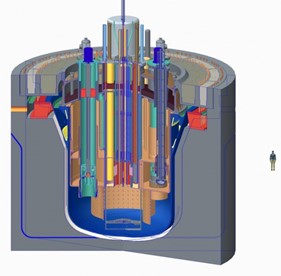Probleemstelling:
SCK-CEN is developing a research reactor as prototype for the 4th generation of nuclear reactors. It was named MYRRHA (Multi-purpose hYbrid Research Reactor for High-tech Applications) and it has several advantages, such as increased safety and reduced nuclear waste through transmutation. The reactor is scheduled to be commissioned in 2036.

Figure 1: Cross section of the MYRRHA reactor.
MYRRHA will use Lead-Bismuth Eutectic (LBE) as primary coolant. Two primary pumps are used to cool the nuclear reactor and they circulate the primary coolant between the nuclear reactor core and the heat exchangers. LBE poses several challenges that need to be considered during the design phase of the pump. It is corrosive and erosive, which limits the flow velocities within the pump. Furthermore, it has a very high density (about 10 times that of water), which alters significantly the dynamic behavior of the pump. Due to the added mass effect, by which the heavy liquid adds inertia to the structural inertia, the natural vibration frequency of the pump rotor and the associated damping will change compared to a vibration analysis conducted in vacuum. As a result, the typical approach to compute the natural frequencies of the blade vibration in vacuum will not yield accurate results.